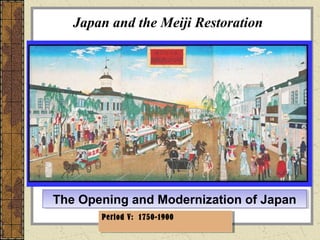The document summarizes Japan's transition from the Tokugawa period to the Meiji Restoration. It discusses how:
1) The Tokugawa period was characterized by isolationism and a rigid social hierarchy. Perry's arrival in 1853 ended this isolation and forced Japan to open trade.
2) Dissatisfaction with the unequal treaties signed with Western powers and a desire to modernize led to the overthrow of the Tokugawa Shogunate.
3) The Meiji Restoration established a centralized state focused on modernizing Japan through political, economic, and social reforms including adopting Western technology and institutions to build a strong military and industrialize the country.










![“When I saw a hospital [abroad], I wanted to know how
it was run – who paid the running expenses; when I
visited a bank, I wanted to learn how the money was
deposited and paid out. By similar firsthand
questions, I learned something of the postal system
and the military conscription (draft). A perplexing
institution was representative government.”
“When I saw a hospital [abroad], I wanted to know how
it was run – who paid the running expenses; when I
visited a bank, I wanted to learn how the money was
deposited and paid out. By similar firsthand
questions, I learned something of the postal system
and the military conscription (draft). A perplexing
institution was representative government.”
Fukuzawa Yukichi
Japanese Scholar
Selective Borrowing
Taiping Rebellion
1850-1864
U.S. Civil War
1861-1865Suez Canal
1858-1869
World Events](https://image.slidesharecdn.com/meijirestorationversion2-1226411917891665-9/85/Meiji-Restorationversion2-11-320.jpg)
















